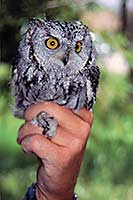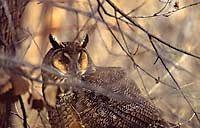August in Canyon Country is a prime time to go nocturnal. With daytime temperatures soaring into the 90s and low 100s, the cooler hours of dawn and dusk are ideal times for exploring the desert. Even at night, with a star-studded sky suspended above or a brilliant moon illuminating the way, a stroll through the desert introduces one to life in the darkness..jpg)
Nighttime is an active period in the desert. Many species of wildlife such as desert cottontails, black-tailed jackrabbits, northern grasshopper mice, kangaroo rats, midget-faded rattlesnakes, mule deer, kit foxes, coyotes, and, of course, other owls own the night. All these creatures avoid the heat of day so the owls use the cover of darkness to hunt for prey.
Great horned owls are found from northern Canada (the great horned owl is the provincial bird of Alberta, Canada) to South America. They are the most widespread species in North America occurring in woodlands, canyons, prairies, urban and rural areas. Nesting in rocky alcoves or abandoned hawk nests, these owls live in just about every habitat in the Canyonlands region except for the high alpine peaks.
The largest of all North American owls, the great horned has a dark-brown to grayish-brown mottled back and dark underparts. This plumage helps them to blend into their surroundings which is useful for avoiding detection while on their day roosts. During the day, jays, robins or crows may dive bomb or harass a roosting owl to drive it out of their territory.
Otherwise, locating a roosting owl may be challenging but during the night there is little chance of mistaking a great horned’s deep hoots for another owl, especially as the cadence of “Who’s Awake? Me, Too” pierces the night’s stillness. In addition to the deep hoots, juvenile and adult female owls may make a shrieking call which resembles that of a barn owl. And when great horned owls duet, the male’s calls have a lower pitch than the female’s hoots. These calls strengthen pair bonds and define their territories.
Since great horned owls occur in a variety of habitats, their diet selection is fairly wide. From mice to rabbits, squirrels to skunks, and bats to rats, these owls eat just about anything they can catch. They’ve earned their nickname “the Flying Tiger” not only for their predatory nature but for their tenacity when protecting their nests or young.
But as fall approaches, adult great horned owls may drive their juveniles out of the natal area. Parenthood only goes so far with these owls.
 Though great horned owls are by far the most commonly encountered owl in the Canyon Country, other species such as long-eared owl, short-eared owl, barn owl, flammulated owl, western screech-owl, northern saw-whet owl, burrowing owl, and the endangered spotted owl inhabits the canyons or forests of the Southwest.
Though great horned owls are by far the most commonly encountered owl in the Canyon Country, other species such as long-eared owl, short-eared owl, barn owl, flammulated owl, western screech-owl, northern saw-whet owl, burrowing owl, and the endangered spotted owl inhabits the canyons or forests of the Southwest.
So, when out enjoying an August evening, keep an ear open for the deep hooting calls of a great horned owl and feel secure in knowing you’re too large of prey for these Flying Tigers.

.jpg)

 Though great horned owls are by far the most commonly encountered owl in the Canyon Country, other species such as long-eared owl, short-eared owl, barn owl, flammulated owl, western screech-owl, northern saw-whet owl, burrowing owl, and the endangered spotted owl inhabits the canyons or forests of the Southwest.
Though great horned owls are by far the most commonly encountered owl in the Canyon Country, other species such as long-eared owl, short-eared owl, barn owl, flammulated owl, western screech-owl, northern saw-whet owl, burrowing owl, and the endangered spotted owl inhabits the canyons or forests of the Southwest.